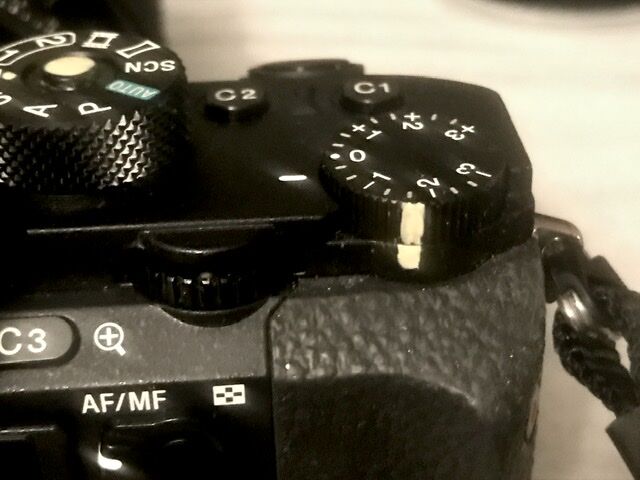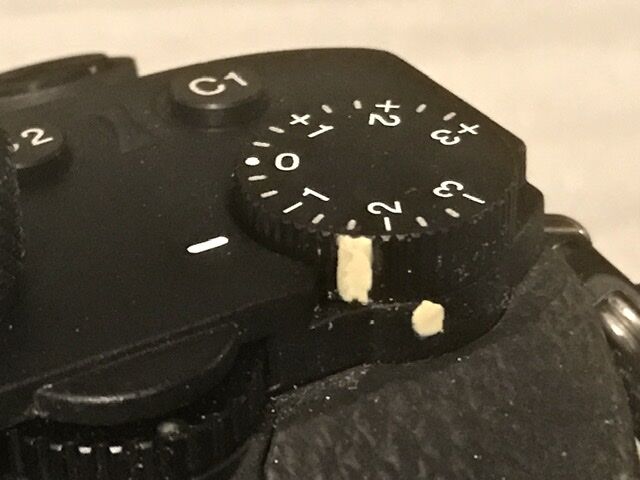Why would you use the exposure compensation dial?
Nov 25, 2022 17:38:39 #
I have never used the exposure compensation dial on any of my cameras. If I need more or less light I change the aperture, shutter or ISO.
What I would like to find out from all of you is why you use the dial as opposed to just changing the aperture, shutter or ISO?
One of the "cons" I have thought of is that if you forget to set it back to zero then your next photo shoot will not be properly exposed.
Please share your thoughts, pro and con, about using the dial over my usual method. Your answers may show me that I'm missing out on a useful "tool" for my photography or it just may confirm my preferred method.
Thank so much for sharing your experience!!
Dodie
What I would like to find out from all of you is why you use the dial as opposed to just changing the aperture, shutter or ISO?
One of the "cons" I have thought of is that if you forget to set it back to zero then your next photo shoot will not be properly exposed.
Please share your thoughts, pro and con, about using the dial over my usual method. Your answers may show me that I'm missing out on a useful "tool" for my photography or it just may confirm my preferred method.
Thank so much for sharing your experience!!
Dodie
Nov 25, 2022 17:42:43 #
You use the exposure compensation dial so that you can increase or decrease exposure but you don't have to switch the camera to manual mode. That's all. I never use it either but each has his/her own way of doing things. There is no right or wrong way.
Nov 25, 2022 17:47:38 #
Nov 25, 2022 18:21:46 #
larryepage
Loc: North Texas area
luvmypets wrote:
I have never used the exposure compensation dial o... (show quote)
Hi Dodie.
I have one camera that produces the best images when I expose about 2/3 stop below what the meter says. This is true no matter what metering/exposure mode I use. So for that camera, I use Exposure Compensation to adjust my actual exposures by that amount in all cases. That camera also has another menu option that will accomplish the same thing, but it's a little more hidden and a little harder to find quickly if necessary. There are other times when EC can be very convenient to use, as well...such as when I am in a strong backlight situation that requires adjustment on all exposures.
We just had an extended and fairly energetic discussion of this topic a couple of weeks ago. Bottom line...EC is just a convenient and quickly accessible function for adjusting exposure. Turns out that it works differently on some cameras from what it does on others. It's available if you want to use it or find it helpful, and, like almost everything else we do in photography, there is at least one other way to accomplish the same thing if it doesn't work for you.
Nov 25, 2022 18:41:48 #
BebuLamar wrote:
You use the exposure compensation dial so that you can increase or decrease exposure but you don't have to switch the camera to manual mode. That's all. I never use it either but each has his/her own way of doing things. There is no right or wrong way.
Thank you, BebuLamar!! I appreciate you taking the time to answer my question.
Dodie
Nov 25, 2022 18:42:58 #
TriX wrote:
I see at mainly useful for auto or program modes.
Thank you, TriX!! I can see where it would be useful in those modes.
Dodie
Nov 25, 2022 18:47:55 #
larryepage wrote:
Hi Dodie. br br I have one camera that produces... (show quote)
Thank you for this information, Larry!! I appreciate you taking the time to answer. I somehow missed that discussion so I will look for it.
Just out of curiosity, how did you determine the camera was best metered 2/3 of a stop below the meter versus it just being a difference between camera and computer?
Dodie
Nov 25, 2022 19:20:26 #
luvmypets wrote:
I have never used the exposure compensation dial o... (show quote)
I use it in program or other auto modes when I need to over or underexpose to get the look I want different from what the meter says.
Sometimes I take several shots and look to see which I like and delete the rest.
Nov 25, 2022 19:25:13 #
luvmypets wrote:
I have never used the exposure compensation dial o... (show quote)
Like you, I havent found any use for it. I really resent to space it takes up and the clutter it creates.
Ive even added warning markers to my cameras to alert me in case the EC dial gets accidentally moved off of zero. The markings are prominently visible from behind the camera.
Nov 25, 2022 20:17:46 #
wdross
Loc: Castle Rock, Colorado
luvmypets wrote:
I have never used the exposure compensation dial o... (show quote)
I shoot almost exclusively with Program Mode and Exposure Compensation. I first set the exposure compensation to produce the image that appears properly exposed and/or proper highlights or shadow details. This is usually -0.3 exposure compensation about 90% of the time (camera starting point is set there). This can be 0 to 5 seconds depending how long I check the image. Then I check the aperture/shutter ratio to see whether I need to change it to meet the needs of the scene (a single top dial). This can be 0 to 5 seconds more. If I have any doubts whether or not I have covered the highlights or shadow details properly, a rotation of the exposure compensation dial, which surrounds the shutter button, easily takes care of any wanted or needed changes. Most of the time I can easily get off 5 to 10 different exposures in about as many seconds. Or take my time watching the action for needed changes.
In my opinion, Program Mode and Exposure Compensation is the easiest way to control the image. There will be times when tighter control of aperture, shutter, and ISO will be needed and other modes will be a better option. But until they are needed, I will be shooting Program Mode and Exposure Compensation most of the time.
Nov 25, 2022 20:31:20 #
Architect1776 wrote:
I use it in program or other auto modes when I need to over or underexpose to get the look I want different from what the meter says.
Sometimes I take several shots and look to see which I like and delete the rest.
Sometimes I take several shots and look to see which I like and delete the rest.
Thank you Architect1776!! I rarely use an auto mode but it would probably be time well spent to experiment with this in case I ever need a program mode. Thanks for taking the time to share this information.
Dodie
Nov 25, 2022 20:33:24 #
larryepage
Loc: North Texas area
luvmypets wrote:
Thank you for this information, Larry!! I appreciate you taking the time to answer. I somehow missed that discussion so I will look for it.
Just out of curiosity, how did you determine the camera was best metered 2/3 of a stop below the meter versus it just being a difference between camera and computer?
Dodie
Just out of curiosity, how did you determine the camera was best metered 2/3 of a stop below the meter versus it just being a difference between camera and computer?
Dodie
Years ago, I took some photography courses at the local college. The first thing we did was experiment to determine the accuracy of our in-camera and hand-held light meters, as well as our shutters and apertures. We did it by measuring the "density" of our negatives after exposing and processing our film "normally." Since then, I've checked my cameras to see what yields the best exposure. It's a combination of looking at several things, including the histogram and my JPEG images under at least somewhat controlled conditions. It's very admittedly not 100% scientific, but I've found that my results are better if I do it than if I don't.
So anyway, I like EC and use it quite a bit. Lots of folks don't and still do just fine. I agree that it can be just as easy to manually adjust from the visible meter. But I do much of my shooting in modes other than manual, which means that I can either have two different ways of doing things or just use EC in all cases. A possible complication, though, is that there are apparently a good number of cameras in which Exposure Compensation does not work when using Manual. That was a surprise to me to learn, bacause it works fine in all modes on my cameras.
I think the whole thing probably doesn't merit a whole lot of energy. Just whatever works best for you and for your camera.
Nov 25, 2022 20:38:36 #
User ID wrote:
Like you, I havent found any use for it. I really resent to space it takes up and the clutter it creates.
Ive even added warning markers to my cameras to alert me in case the EC dial gets accidentally moved off of zero. The markings are prominently visible from behind the camera.
Ive even added warning markers to my cameras to alert me in case the EC dial gets accidentally moved off of zero. The markings are prominently visible from behind the camera.
Wow! Your dial really is in an inconvenient location and you were really smart to mark it. I can see how it could easily get bumped out of position. Both of my cameras have a button located on top near the shutter button and though I don't think it's ever happened it's possible that in a hurry I could bump it and turn the selector accidentally changing the setting thinking I'm adjusting something else. Now that you've made me aware I will check this when I go over my settings before I take photos.
Thank you for sharing that idea. I'm sure it will be helpful.
Dodie
Nov 25, 2022 20:42:15 #
Nov 25, 2022 20:45:27 #
larryepage wrote:
Years ago, I took some photography courses at the ... (show quote)
In the back of my mind I remember doing something similar in a photography class with one of my old film cameras taking photos with an 18% gray card. I do understand what you are saying about checking the histogram and I may try something similar to see how my D750 and D810 do.
Thanks so much. I really appreciate it!!
Dodie
If you want to reply, then register here. Registration is free and your account is created instantly, so you can post right away.






